
Capitol Heights is a town in Prince George's County, Maryland, United States, located on the border of both the Northeast & Southeast quadrants of Washington. The town of Capitol Heights is officially bounded between Southern Avenue NE/SE to the north, Yost Place, and Eastern Avenue NE to the east, the Watts Branch Stream, Brooke Road, and Capitol Heights Boulevard to the south, and Marlboro Pike to the west. The zip code of Capitol Heights is 20743.
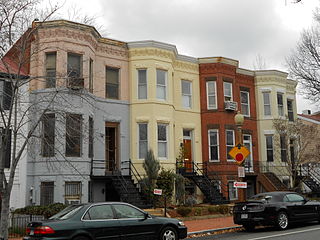
Capitol Hill, in addition to being a metonym for the United States Congress, is the largest historic residential neighborhood in Washington, D.C., stretching easterly in front of the United States Capitol along wide avenues. It is one of the oldest residential neighborhoods in Washington, D.C., and, with roughly 35,000 people in just under 2 square miles (5 km2), it is also one of the most densely populated.
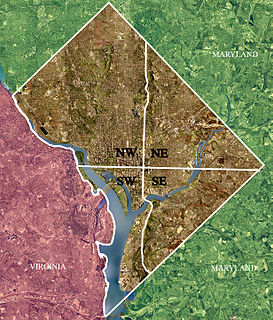
Northwest is the northwestern quadrant of Washington, D.C., the capital of the United States, and is located north of the National Mall and west of North Capitol Street. It is the largest of the four quadrants of the city, and it includes the central business district, the Federal Triangle, and the museums along the northern side of the National Mall, as well as many of the District's historic neighborhoods.
Benning Road is a major traveled street in Washington, D.C., and Prince George's County, Maryland.

Deanwood is a neighborhood in Northeast Washington, D.C., bounded by Eastern Avenue to the northeast, Kenilworth Avenue to the northwest, Division Avenue to the southeast, and Nannie Helen Burroughs Avenue to the south.

Swampoodle was a neighborhood in Washington, D.C. on the border of Northwest and Northeast in the second half of 19th and early 20th century. This neighborhood is no longer known as Swampoodle and has been replaced in large part by NoMa.

Massachusetts Avenue is a major diagonal transverse road in Washington, D.C., and the Massachusetts Avenue Historic District is a historic district that includes part of it.

H Street is a set of east-west streets in several of the quadrants of Washington, D.C. It is also used as an alternate name for the Near Northeast neighborhood, as H Street NW/NE is the neighborhood's main commercial strip.

Florida Avenue is a major street in Washington, D.C. It was originally named Boundary Street, because it formed the northern boundary of the Federal City under the 1791 L'Enfant Plan. With the growth of the city beyond its original borders, Boundary Street was renamed Florida Avenue in 1890.
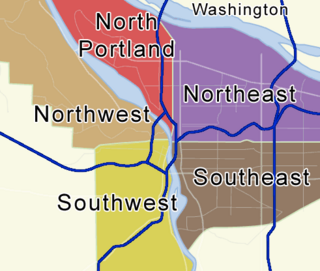
Portland, Oregon is divided into six sections: North Portland, Northeast Portland, Northwest Portland, South Portland, Southeast Portland, and Southwest Portland. There are 95 officially recognized neighborhoods, each of which is represented by a volunteer-based neighborhood association. No neighborhood associations overlap the Willamette River, but a few overlap the addressing sextants. For example, most addresses in the South Portland Neighborhood Association are South, but a portion of the neighborhood is west of SW View Point Terrace where addresses have a SW prefix. Similarly the Buckman Neighborhood Association spans both NE and SE Portland.
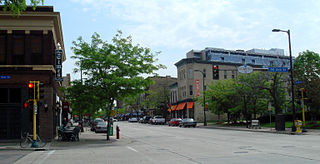
Northeast is a defined community in the U.S. city of Minneapolis, Minnesota, composed of 13 smaller neighborhoods whose street addresses end in "NE". Unofficially it also includes the neighborhoods of the University community which have "NE" addresses, and the entirety of the Old Saint Anthony business district, which sits on the dividing line of "NE" and "SE" addresses. In the wider community, this business district, which is the oldest settlement in the city, is often identified as the heart of Northeast, in part because it lies across the Mississippi River from Downtown Minneapolis. Northeast is sometimes referred to as "Nordeast", reflecting the history of northern and eastern European immigrants and their language influence.

Capitol View is a neighborhood located in southeast Washington, D.C., in the United States. It is bounded by East Capitol Street to the north, Central Avenue SE to the southwest and south, and Southern Avenue SE to the southeast. Still overwhelmingly African-American, it is a thriving middle class neighborhood. Parts of the neighborhood became one of the city's most violent and drug-ridden areas in the 1980s and 1990s. The Capitol View neighborhood has seen several large, poorly maintained public housing projects demolished in the 2010s. The government of the District of Columbia partnered with private real estate developers to construct the Capitol Gateway mixed-use development between 2000 and 2010.
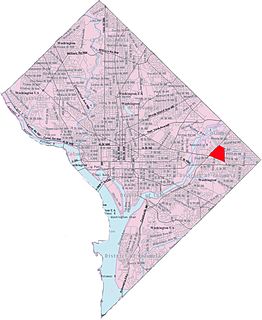
Central Northeast, also sometimes called Mahaning Heights, is a small neighborhood located in Northeast Washington, D.C. with Fort Mahan Park at its center. It is bounded by Nannie Helen Burroughs Avenue to the north, Benning Road to the south, the tracks of the Washington Metro and Minnesota Ave station to the west, and 44th Street NE to the east.

Hillbrook is a neighborhood in Northeast Washington, D.C. It is bounded by Nannie Helen Burroughs Avenue to the north, Brooks Street to the south, 44th Street NE to the west, and Division Avenue to the east.

Lincoln Heights is a residential neighborhood in Northeast Washington, D.C. It is bounded by Nannie Helen Burroughs Avenue NE to the north, Blaine Street NE to the south, Division Avenue NE to the east, and 49th Street NE to the west.

The Nannie Helen Burroughs School, formerly known as National Training School for Women and Girls, was a private coeducational elementary school at 601 50th Street NE in Washington, D.C. The school was founded in 1909 by Nannie Helen Burroughs as The National Trade and Professional School for Women and Girls, Inc. and was the first school in the nation to provide vocational training for African-American females, who did not otherwise have many educational opportunities available to them. The 1928 Trades Hall building, the oldest building on the campus, was declared a National Historic Landmark in 1991. The property now houses the headquarters of the Progressive National Baptist Convention as well as the Monroe School, a private junior-senior high school that continues Burroughs' legacy.

Washington, D.C., is administratively divided into four geographical quadrants of unequal size, each delineated by their ordinal directions from the medallion located in the Crypt under the Rotunda of the Capitol. Street and number addressing, centered on the Capitol, radiates out into each of the quadrants, producing a number of intersections of identically named cross-streets in each quadrant. Originally, the District of Columbia was a near-perfect square. However, even then the Capitol was never located at the geographic center of the territory. As a result, the quadrants are of greatly varying size. Northwest is quite large, encompassing over a third of the city's geographical area, while Southwest is little more than a neighborhood and military base.
The Benning Heights–Alabama Avenue Line, designated Route V7, V8, is a daily bus route operated by the Washington Metropolitan Area Transit Authority between Minnesota Avenue station of the Orange Line of the Washington Metro and Congress Heights station (V7) of the Green Line of the Washington Metro or the neighborhood of Benning Heights (V8). The line operates every 25-30 minutes at all times. Route V7 trips are roughly 45 minutes while route V8 trips are roughly 15 minutes.

The Benning Road–H Street Limited Line, designated Route X9, is a limited stop MetroExtra bus route operated by the Washington Metropolitan Area Transit Authority between Capitol Heights station, which is served by the Blue and Silver lines of the Washington Metro, and Metro Center station, which is served by the Red, Blue, Orange, and Silver lines of the Washington Metro. The line operates every 15-16 minutes at all times on weekdays only. Trips are roughly 50 minutes long. During weekday midday, Route X9 is shortened to operate to Minnesota Avenue station. This line provides additional service along the H Street corridor supplementing routes X1, X2 and X3.
The Capitol Heights–Minnesota Avenue Line, designated Route V2, V4, is a daily bus route operated by the Washington Metropolitan Area Transit Authority between Capitol Heights station of the Blue and Silver Lines of the Washington Metro and Anacostia station (V2) or Navy Yard–Ballpark station (V4) of the Green Line of the Washington Metro. The line runs every 24–30 minutes on weekdays and 30-35 minutes on weekends. Trips take roughly 45-50 minutes.


















